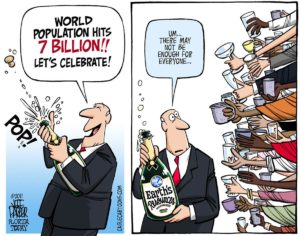The Green New Deal is basically just a framework for a society to cut climate emissions by cutting fossil fuel use. Most of the details remain to be devised. The principle pillar most commonly cited is that of 100% renewable energy, but again, the type of society to be fueled by renewables is undefined. Richard Heinberg has explained that human societies “didn’t have to wait for biological evolution to slowly deliver improved organs. Cultural evolution rapidly supplied new ideas, behaviors, and tools that enabled us to take over habitat from other creatures. Starting roughly in the 19th century, concentrated energy of fossil fuels sped up cultural evolution to the point where disruptive cultural innovations . . . are spiraling entirely out of our control, notably, the planetary feedbacks associated with climate change”. – Power, the Acceleration of Cultural Evolution, and Our Best Hope for Survival. It’s not just the type of energy use that must change, but the quantity and pace of energy use.
Award winning ecological and energy journalist, Andrew Nikifaruk, has written “We have a ways to go if we choose to reduce emissions by simply replacing fossil fuels with wind turbines. What also matters is using less energy. We have to look at downsizing, degrowth, using less”. Those are critical considerations for crafting a successful Green New Deal. It’s not easy to grasp the kind of energy transition that must take place by comparing the various percentages of renewables growth and ratios of fossil vs. renewable use rates. But consider how Tad Patzek, a professor of petroleum and chemical engineering in Texas, puts it. “If we divide the days of the year up based on total energy use, fossil fuels — oil, coal and natural gas — powered the globe for 321 days in 2018. Dams and nuclear power kept the lights on for 15 days. Renewables energized the globe for only about 29 days, and most of that energy came from biomass or wood burning.”

Roger Pielke Jr., a Colorado professor, recently noted “If we really wanted to reach zero carbon emissions by 2050, and we solely choose wind power as the solution, we’d need to build and deploy 1,500 wind turbines on about 300 square miles every day for the next 30 years”. That’s impossible, if for no other reason than the amount of fossil fuel needed to build them. But it illustrates the magnitude of society’s challenge. The math doesn’t work to simply keep the party going with renewables. Globally, electrical demand has been rising faster than the increase in production from renewables for decades, with little or no change. David Hughes, one of Canada’s most esteemed energy analysts, pointed out that “We need to radically reduce energy consumption and use renewables to actually retire fossil fuel infrastructure”. To date, the evidence shows that we have largely used renewables to consume more energy – It Bears Repeating: Renewables Alone Won’t End the Climate Crisis.
Nate Hagens, a former Wall Street wolf and now an adjunct professor at the University of Minnesota, emphasizes that our current energy glut lifestyle and the Green New Deal both suffer from the same shortcomings. Neither understand that it’s energy flows which underpin economic flows and growth. Longtime energy analyst, Andrew Nikifaruk explains, “The fossil fueled business-as-usual model pretends that expensive fossil fuels like fracked oil or bitumen can replace cheap conventional stuff with no global economic contraction. They can’t. The Green New Deal model pretends that renewables can provide the same quality and quantity of energy as fossil fuels with no global upheaval. They can’t. Both ignore the limits imposed when 7.7 billion human beings are consuming the planet, and the dire consequences of that for biodiversity. Any way you look at it, overpopulation is part of the problem.”

Hagens thinks the world needs a non-partisan conversation about this reality, and about how to prepare for a 30-per-cent drop in energy consumption. He says civilization has three options: it can muddle on, bend, or break. Muddling is what we are doing now. So far, no one is talking about bending. That would require dramatic reductions in energy spending and a different way of living. But that’s the keystone to a realistic, though extremely difficult, Green New Deal – The Green New Deal Battles Business as Usual. Both Will Doom Us.


Recent Comments